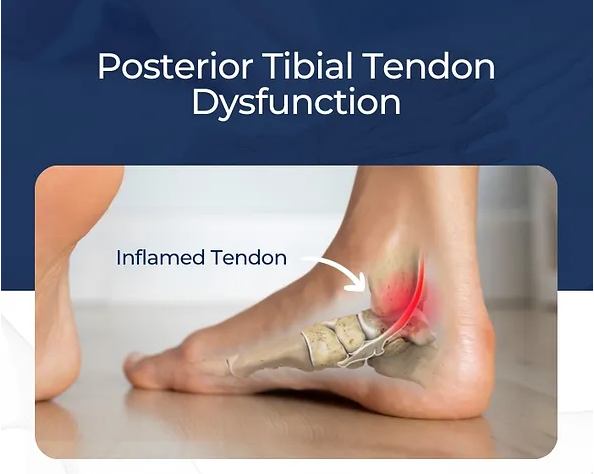
PTTD is a progression from tendonitis to a condition where the tendon is damaged to the point where it can no longer support the arch of the foot, also referred to as ‘flatfoot deformity.’ This condition reflects both the inflammatory process and the mechanical failure of the tendon to perform its function.
What Causes Posterior Tibial Tendon Dysfunction (PTTD)?
Posterior tibial tendon dysfunction (PTTD) can develop from various things, let’s take a look at the table below which highlights things like hiking, age, and even obesity as causes for Posterior tibial tendon dysfunction.
| Causes | Activity |
|---|---|
| Overuse | Activities like running, walking, and climbing stairs can overuse the posterior tibial tendon, leading to PTTD. |
| Age-Related Degeneration | As we age, the tendon weakens naturally, increasing the risk of injury. |
| Obesity | Excess weight puts additional strain on the tendon, accelerating its breakdown. |
| Previous Injuries | Ankle, foot, or joint injuries can damage the tendon and contribute to PTTD. |
| Younger Population | While less common, PTTD can occur in younger individuals following injuries. |
What Are The Symptoms of Posterior Tibial Tendon Dysfunction
The symptoms of posterior tibial tendon dysfunction are different for each person. You may experience a combination of symptoms such as pain, swelling, and rolling for foot inward. Pay attention to your feet if you experience any of these symptoms.
- Pain and swelling: Inner ankle or foot, especially worse when standing or walking.
- Toe walking trouble: Difficulty standing on your toes due to pain.
- Rolling inward: Your ankle rolls inward when you walk or stand.
- Uneven surfaces: Difficulty walking on uneven ground or stairs.
- Limping: A worsening limp you might have noticed.
- Shoe wear: Unusual or uneven wear patterns on your shoes.

What Are The Stages of Posterior Tibial Tendon Dysfunction
Posterior Tibial Tendon Dysfunction (PTTD) progresses through various stages, each with its own set of symptoms and treatment options. Understanding these stages can help to effectively manage PTTD.
Stage 1
- Intact but Injured Tendon: At this early stage, the tendon is injured or stretched but still intact.
- Symptoms: Mild pain and swelling along the inside of the foot and ankle, often experienced more in the instep during walking or running. Standing on the affected foot is still possible.
Stage 2
- Partially Torn Tendon: Stage 2 PTTD is generally characterised by a partially torn tendon.
- Symptoms: Increased pain and limited mobility compared to Stage 1.
- Collapsed Foot Arch: The arch of the foot may begin to collapse, causing a flatter appearance.
- Activity Limitations: Simple activities like walking can become challenging.
Stage 3
- Complete Tear: At this advanced stage, the tendon is completely torn, resulting in severe deformity and flatfoot.
- Symptoms: Significant pain, severe deformity, and flatfoot.
- Mobility Restriction: The heel loses flexibility, and mobility is significantly restricted.
- Surgical Intervention: Surgical intervention is often required to address the condition and relieve pain.
- Arthritis Risk: The cartilage in your ankles may be worn down, eventually leading to very painful osteoarthritis.
Stage 4
- Degenerative Changes: This is the most severe stage, where degenerative changes occur in the ankle joint itself, often leading to arthritis.
- Symptoms: Ankle tilt, outward pointing toes, and potential for severe pain.
- Ankle Deformity: The ankle may start to tilt down and inwards, while the toes may start to point outwards instead of pointing straight.
How is Posterior Tibial Tendon Dysfunction Diagnosed?
Diagnosing posterior tibial tendon dysfunction (PTTD) involves a two-pronged approach: a detailed examination by your trusted podiatrist in Kew combined with potential imaging tests. During the examination, your podiatrist will delve into your medical history, specifically focusing on any changes you’ve noticed in your foot.
A thorough physical assessment of your foot, ankle, and calf will follow. This includes checking your range of motion, tenderness, swelling, and your ability to stand on your tiptoes. These initial steps can provide valuable clues about the potential presence of PTTD.
What Tests Can Diagnose Posterior Tibial Tendon Dysfunction?
To confirm the diagnosis and determine the stage of the condition, your podiatrist might recommend imaging tests. X-rays, MRIs, CT scans, and ultrasounds are all potential tools in the diagnostic arsenal.
These tests offer a clearer picture of the extent of tendon damage, allowing your podiatrist to tailor the treatment plan specifically to your needs.
By combining the information gathered from the physical examination and any imaging tests, your podiatrist can confidently diagnose PTTD and guide you towards the best treatment plan for you.
How Do You Treat Posterior Tibial Tendon Dysfunction?
The treatment plan for posterior tibial tendon dysfunction (PTTD) depends on the severity of your condition. In most cases, a non-surgical approach is preferred. You may need to take medication, buy supportive shoes, and exercising. However, if surgery is required, we can guide you through the process. The table below outlines the different types of treatments for posterior tibial tendon dysfunction.
Nonsurgical Treatment
| Treatment | Description |
|---|---|
| Rest, Ice, and Medication | Reducing inflammation with rest, ice therapy, and anti-inflammatory drugs like ibuprofen is a crucial first step. |
| Immobilisation | Limiting movement through a walking boot or cast allows the tendon and surrounding tissues to heal. |
| Supportive Footwear | Custom orthotics and inserts provide arch support and pain relief. Ankle braces may also be used for additional support. |
| Strengthening Exercises | Specific exercises target the muscles that support the foot and ankle, particularly the tibialis anterior, to improve stability and function. Physical therapy can further guide you in these exercises and stretches to manage pain. |
Surgical Approach
If conservative methods fail to manage PTTD, particularly in advanced stages, surgery may be necessary. Surgical procedures aim to realign the foot and restore function. These can involve tendon transfers, bone restructuring (osteotomies), or fusions to correct the deformity.
What is Posterior Tibial Tendonitis, and How Does It Differ from Posterior Tibial Tendon Dysfunction?
Tendonitis refers to the early, primarily inflammatory stage due to overuse or injury, while dysfunction indicates a progression to mechanical insufficiency with more significant structural and functional implications for the foot. The critical difference between the two conditions lies in the stage and severity of the tendon’s damage and the impact on foot function. Early detection and treatment of posterior tibial tendonitis can prevent or slow the progression to PTTD, emphasising the importance of seeking medical advice when symptoms first appear.
What is Tibialis Posterior Tendon?
The Tibialis Posterior Tendon is a vital structure in the foot that attaches the tibialis posterior muscle, located in the calf, to the bones of the foot. Its primary function is to support the arch and assist in walking by enabling the foot to move inward and stabilise during gait.
What is Tibialis Posterior Tendinopathy vs PTTD?
Tibialis Posterior Tendinopathy refers to degenerative changes in the posterior tibial tendon without significant inflammation. It is characterised by pain, swelling, and decreased tendon function. PTTD, or Posterior Tibial Tendon Dysfunction, is a progression of tendinopathy where the tendon can no longer support the foot’s arch, leading to flatfoot deformity. PTTD includes tendinopathy symptoms, arch collapse, and changes in foot structure.
What is Adult Acquired Flatfoot (AAF), and How Does It Differ from PTTD?
AAF is a broader term that describes the progressive flattening of the arch of the foot occurring in adults, leading to a flatfoot deformity. While PTTD is a primary cause, AAF can also result from other conditions, such as arthritis, injury to the foot or ankle, or dysfunction of other tendons in the foot.
Causes of AAF
Besides PTTD, causes include trauma, degenerative diseases (like rheumatoid arthritis), and neuropathic conditions (such as those resulting from diabetes).
At Align Health Collective, we are committed to giving our patients the utmost care and support. We guide our patients from the moment they come in for a consultation until they receive a diagnosis because we know how difficult it can be to live with PTTD.
FAQs about Posterior Tibial Tendon Dysfunction
How soon after treatment will I feel better?
You may only notice significant relief after several months. Healing from PTTD takes time and patience. Because everyone is different, and there are many treatment options, you will find that the recovery time will change as well. Recovery after surgery can take longer, with pain relief starting within weeks and full recovery potentially taking 6–12 months or even longer depending on the complexity of the procedure.
How can I reduce my risk of developing posterior tibial tendon dysfunction?
To minimise your risk of PTTD, choose shoes with ample arch support, do not wear high heels, platforms, and flip-flops that lack proper structure. Regularly stretch your lower legs with standing calf stretches and utilise a foam roller to loosen calf muscles. Additionally, incorporate strengthening exercises like resistance band work, single-leg heel raises, and short toe walks to bolster your foot and ankle stability, all while listening to your body and stopping activities that cause discomfort. By prioritising these steps, you can significantly reduce your chances of developing PTTD.
Can you walk on a torn posterior tibial tendon?
Walking with a torn posterior tibial tendon is possible, but painful. When this tendon located behind the ankle becomes inflamed or torn, it can lead to pain on the inner ankle and foot, contribute to flatfoot development, and cause overall dysfunction.
Back to top: What is Posterior Tibial Tendon Dysfunction?
